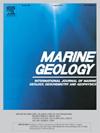Geomorphic processes within the La Gomera-Tenerife Channel (Canary Islands): Decoding the interaction of bottom currents with seabed topography
IF 2.6
3区 地球科学
Q2 GEOSCIENCES, MULTIDISCIPLINARY
引用次数: 0
Abstract
The La Gomera-Tenerife Channel is a narrow passage between La Gomera and Tenerife Islands, i.e., two volcanic edifices of the Canary Archipelago (Atlantic Ocean). A geophysical study was conducted to identify the main geomorphic processes affecting the seabed and their interplay. In particular, submetric resolution bathymetric and side scan sonar backscatter data were collected in the southern sector of the Channel, down to 1200 m water depth. Their integrated analysis revealed a complex seabed morphology and a variety of morpho-sedimentary features, resulting from three main geomorphic processes: submarine volcanic activity, mass wasting (e.g., turbidity currents, small landslides and exotic blocks emplaced by a massive landslide event), and bottom currents activity. Bottom currents strongly reshaped the seabed into bedforms, confined drifts, and moats. Although the flanks of volcanic islands are typically dominated by mass wasting and volcanic features, our results indicate that bottom current activity can be predominant in confined settings and around topographic features due to modification of flow patterns and enhancement of current flows.
This study is the first to document volcanic, mass wasting and bottom current features within the La Gomera-Tenerife Channel. Furthermore, it provides insights on: i) morpho-sedimentary reconstructions of narrow passages between volcanic islands; ii) interplay among different geomorphic processes; iii) oceanographic reconstructions. The variety of geomorphic processes shaping the La Gomera-Tenerife Channel makes this area significant for high-resolution studies. Moreover, it provides new insights on poorly known processes, such as: the interaction of bottom currents with complex topography and bottom current morpho-dynamic in curved moats.
拉戈梅拉-特内里费海峡(加那利群岛)的地貌过程:解码底流与海底地形的相互作用
La Gomera-Tenerife 海峡是加那利群岛(大西洋)的两个火山岛 La Gomera 和 Tenerife 之间的一条狭窄通道。为确定影响海底的主要地貌过程及其相互作用,进行了地球物理研究。特别是,在水深达 1200 米的海峡南段收集了亚米级分辨率的测深和侧扫声纳反向散射数据。综合分析表明,海底形态复杂,形态沉积物特征多样,主要由三个地貌过程造成:海底火山活动、大面积流失(如浊流、小型滑坡和大规模滑坡事件造成的奇特岩块)和底流活动。底流将海床强烈地重塑为床形、封闭漂流和护城河。虽然火山岛的侧面通常主要是块状剥蚀和火山地貌,但我们的研究结果表明,由于水流模式的改变和水流的增强,底流活动在封闭环境和地形地貌周围可能占主导地位。这项研究首次记录了拉戈梅拉-特内里费岛海峡的火山爆发和底流特征。此外,它还提供了以下方面的见解:i) 火山岛之间狭窄通道的形态沉积重建;ii) 不同地貌过程之间的相互作用;iii) 海洋学重建。塑造拉戈梅拉-特内里费岛海峡的地貌过程多种多样,这使得该地区对高分辨率研究具有重要意义。此外,它还为一些鲜为人知的过程提供了新的见解,例如:底流与复杂地形的相互作用,以及弯曲护城河中的底流形态动力。
本文章由计算机程序翻译,如有差异,请以英文原文为准。
求助全文
约1分钟内获得全文
求助全文
来源期刊

Marine Geology
地学-地球科学综合
CiteScore
6.10
自引率
6.90%
发文量
175
审稿时长
21.9 weeks
期刊介绍:
Marine Geology is the premier international journal on marine geological processes in the broadest sense. We seek papers that are comprehensive, interdisciplinary and synthetic that will be lasting contributions to the field. Although most papers are based on regional studies, they must demonstrate new findings of international significance. We accept papers on subjects as diverse as seafloor hydrothermal systems, beach dynamics, early diagenesis, microbiological studies in sediments, palaeoclimate studies and geophysical studies of the seabed. We encourage papers that address emerging new fields, for example the influence of anthropogenic processes on coastal/marine geology and coastal/marine geoarchaeology. We insist that the papers are concerned with the marine realm and that they deal with geology: with rocks, sediments, and physical and chemical processes affecting them. Papers should address scientific hypotheses: highly descriptive data compilations or papers that deal only with marine management and risk assessment should be submitted to other journals. Papers on laboratory or modelling studies must demonstrate direct relevance to marine processes or deposits. The primary criteria for acceptance of papers is that the science is of high quality, novel, significant, and of broad international interest.
 求助内容:
求助内容: 应助结果提醒方式:
应助结果提醒方式:


